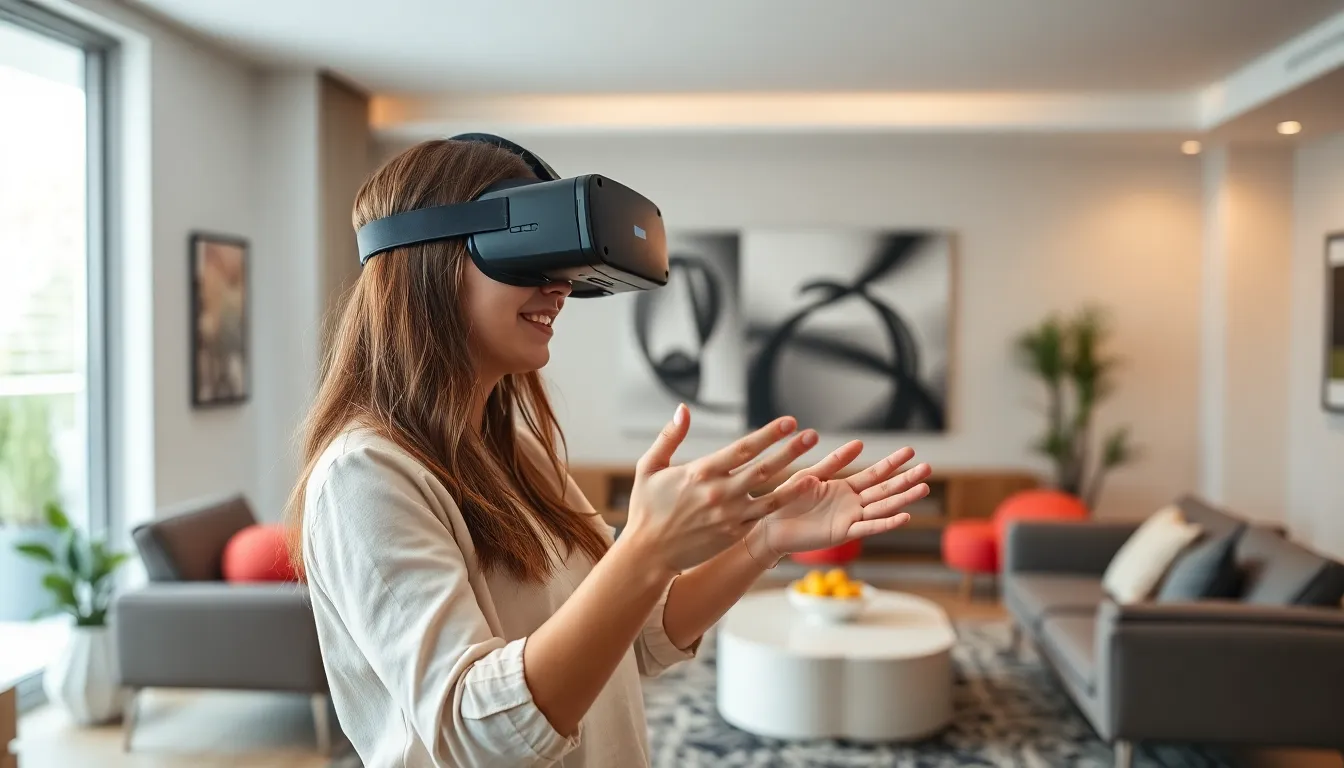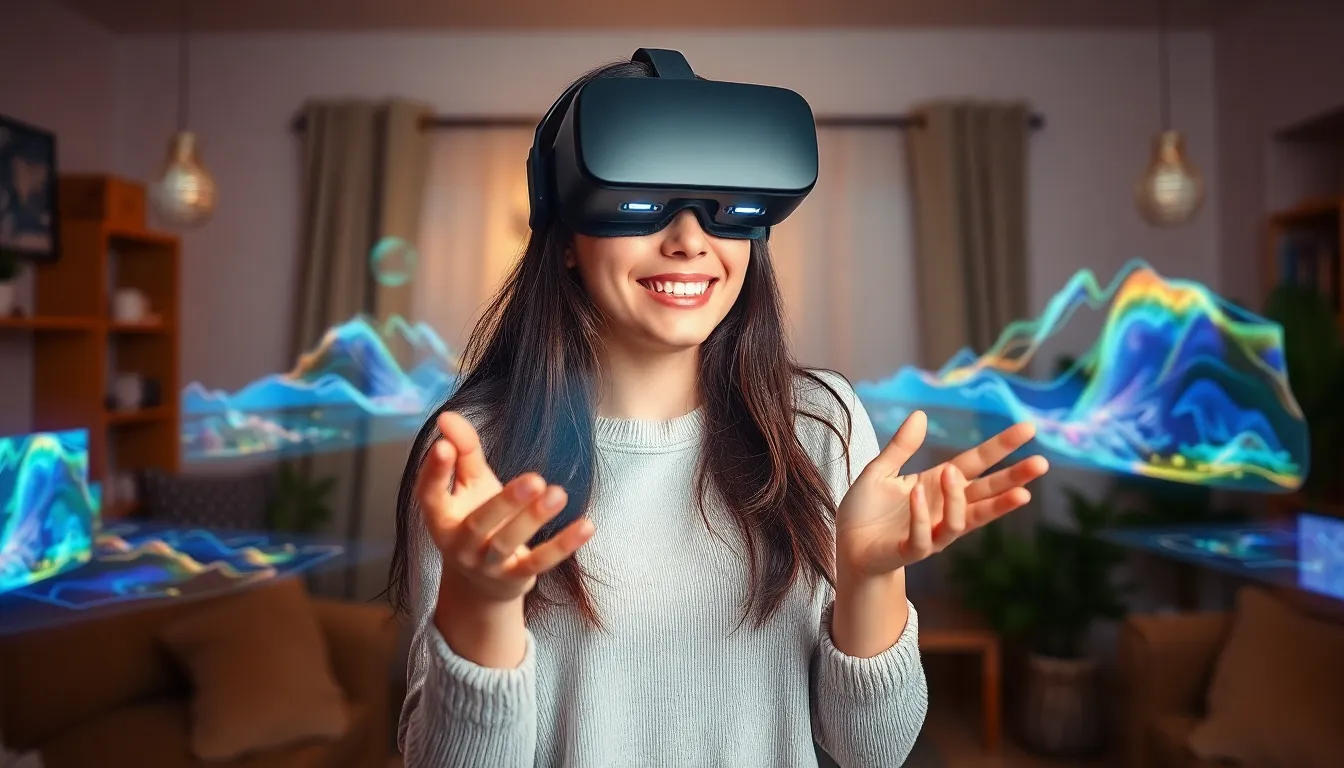In a world where reality sometimes feels a bit too real, virtual concepts are stepping in to save the day. Imagine a realm where creativity knows no bounds and the impossible becomes possible—all from the comfort of your couch. From virtual reality escapades to digital design marvels, these concepts are revolutionizing how people interact, work, and play.
Table of Contents
ToggleOverview of Virtual Concepts
Virtual concepts revolutionize the way individuals engage with their surroundings. These innovations create immersive experiences that reshape interaction, work, and entertainment.
Definition and Significance
Virtual concepts encompass a range of digital experiences, including augmented reality, virtual reality, and immersive environments. These technologies represent significant advancements in human-computer interaction. By providing lifelike simulations, they enhance user engagement and learning. Many industries, from gaming to education, leverage virtual concepts to increase efficiency and creativity. Relevant examples include simulations for training purposes and virtual meetings that streamline collaboration.
Historical Context
The origins of virtual concepts trace back to the 1960s with pioneers like Ivan Sutherland introducing the first head-mounted display. In the 1980s, significant developments occurred with the introduction of virtual reality systems and computer-generated imagery. The 1990s brought about increased interest in gaming and entertainment applications, exemplified by early VR arcade machines. As technology progressed, accessibility improved with the introduction of affordable VR headsets in the 2010s. Recent years marked a surge in applications across various sectors, highlighting the growing cultural and economic importance of virtual concepts.
Types of Virtual Concepts

Virtual concepts encompass a range of technologies enhancing human interaction with digital environments. These include virtual reality, augmented reality, and mixed reality, each offering unique experiences.
Virtual Reality
Virtual reality (VR) immerses users in completely digital environments. It employs headsets and sensory equipment to simulate real-life scenarios. Users experience a heightened sense of presence as they navigate through 3D spaces. Various industries, including gaming, education, and training, utilize VR for engaging simulations. For instance, medical professionals train through realistic surgical simulations. Gamers also benefit from expansive worlds that transform gameplay into fully immersive experiences.
Augmented Reality
Augmented reality (AR) overlays digital information onto the real world. This technology enhances users’ perceptions by integrating characters, data, and animated elements into their surroundings. Popular applications include mobile apps like Pokémon GO, which encourages physical exploration while engaging with virtual elements. Retailers use AR to allow customers to visualize products, such as furniture in their homes, before making purchases. Educational institutions also incorporate AR for interactive lessons, making learning more engaging and informative.
Mixed Reality
Mixed reality (MR) combines elements of both virtual and augmented reality. This concept enables interaction with real and virtual objects in real time. Users can manipulate virtual items as though they exist in the physical environment. Microsoft’s HoloLens exemplifies MR, offering applications in design, training, and entertainment. Professionals collaborate more effectively, merging physical and digital realms. MR fosters innovation by allowing creators to visualize concepts before implementation, enhancing problem-solving capabilities across various fields.
Applications of Virtual Concepts
Virtual concepts find applications across various domains, significantly impacting how individuals learn, heal, and entertain themselves.
Education and Training
Virtual concepts transform education by providing immersive learning environments. Students engage with interactive content, enhancing retention rates and comprehension. For instance, virtual simulations allow medical students to practice procedures in a safe space without risks. Additionally, companies employ virtual reality for employee training, offering realistic scenarios that improve skill acquisition. These advancements create a more engaging educational experience, fostering creativity and collaboration among learners.
Healthcare
In healthcare, virtual concepts streamline procedures and patient interactions. Surgeons utilize virtual reality to practice complex operations before performing them in reality, reducing errors. Patients experience enhanced understanding of their conditions through augmented reality applications that visualize health data. Therapists also implement virtual environments for exposure therapy, helping patients overcome phobias safely. Such innovations are revolutionizing patient care and improving outcomes significantly.
Entertainment
The entertainment industry thrives on virtual concepts, presenting new ways for audiences to engage with content. Gamers experience fully immersive worlds, enhancing gameplay and storytelling. Virtual concerts allow fans to attend shows from the comfort of their homes, eliminating geographical barriers. Filmmakers also explore augmented reality to create interactive movie experiences that draw viewers into the narrative. This evolution continually reshapes entertainment options, enriching user experiences across the board.
Challenges and Limitations
Various challenges and limitations affect the implementation and growth of virtual concepts. These barriers hinder the widespread adoption and integration of these innovative technologies.
Technical Barriers
Technical barriers often impede the full potential of virtual concepts. Limited bandwidth and high system requirements restrict user access, particularly in areas with inadequate internet connectivity. Equipment costs also create a significant hurdle, as not everyone can afford VR headsets or advanced hardware. Compatibility issues among different devices and software can further complicate user experiences. Many applications require constant updates, which leads to additional operational challenges. Issues related to latency and motion sickness can detract from immersive experiences, making users hesitant to engage in virtual environments.
User Acceptance
User acceptance remains crucial for the success of virtual concepts. Many individuals express skepticism towards immersive technologies, mainly due to unfamiliarity with the experience. Some users feel overwhelmed or anxious when using VR or AR applications, leading to reluctance in embracing these innovations. Age and demographic factors play significant roles in shaping acceptance levels, with older generations often being more resistant to new technologies. Effective marketing and education about the benefits of these concepts can enhance user mindset and drive greater adoption. Social influence, including endorsements from trusted sources, can also encourage users to explore virtual environments.
Ethical Considerations
Ethical considerations pose significant challenges in deploying virtual concepts. Privacy concerns arise as virtual platforms collect extensive user data to personalize experiences. Users may feel uncomfortable sharing personal information, leading to reluctance in adopting such technologies. Moreover, the potential for addiction to immersive environments has sparked debates about user well-being and mental health. Content moderation becomes vital, as inappropriate virtual content can harm vulnerable users. Ensuring equitable access to virtual experiences also garners attention, as disparities in technology access can reinforce existing social inequalities. Addressing these ethical concerns emphasizes a responsible approach to integrating virtual concepts in society.
Future of Virtual Concepts
Innovations in virtual concepts continue to evolve rapidly, bringing exciting possibilities. These advancements shape not just individual experiences but also the broader landscape of technology and society.
Emerging Trends
Innovative developments in artificial intelligence (AI) enhance virtual environments, making interactions more intuitive. Increased focus on social experiences within virtual spaces allows users to collaborate seamlessly, regardless of their physical location. Enhanced realism in graphics elevates user immersion, creating richer sensations during virtual interactions. Growth in health and wellness applications demonstrates the versatility of virtual concepts in therapeutic settings. Data-driven insights personalize user experiences, tailoring content to individual preferences and enhancing overall satisfaction.
Potential Impact on Society
Societal transformation through virtual concepts promises significant benefits in various sectors. Education may see improved learning outcomes as immersive technologies support diverse learning styles. Healthcare could achieve enhanced patient care, allowing for realistic simulations to train medical professionals effectively. Employment dynamics might shift as remote work and virtual collaborations become standard, fostering flexibility and inclusivity. Mental health initiatives may utilize virtual therapies, offering accessible support for individuals worldwide. Life quality for people with disabilities could improve through tailored virtual environments, fostering independence and social engagement.
Virtual concepts are undeniably reshaping the way individuals experience the world. As technology continues to advance the possibilities of virtual reality augmented reality and mixed reality grow exponentially. These innovations not only enhance personal engagement but also revolutionize industries from education to healthcare.
While challenges remain in terms of accessibility and user acceptance the potential benefits are immense. By embracing these technologies society can look forward to a future where immersive experiences enrich daily life. The continued evolution of virtual concepts promises to foster creativity collaboration and well-being across various sectors paving the way for a more connected and innovative world.

